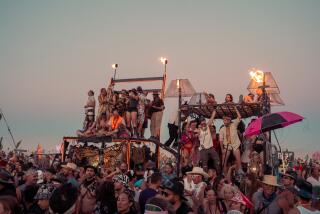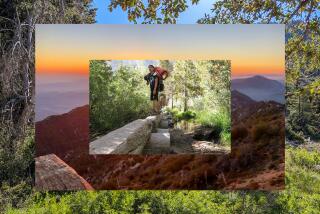Cold and alone, yes. Crazy? Not yet
Crater Lake National Park, Ore. — The LAKE IN THE CRATER IS ROUND AND BLUE. ABOVE IT, on the lip of this blown-out old volcano, the old lodge stands shuttered and snowbound, closed since October. Inside, beyond the empty armchairs and darkened halls, the keeper of Crater Lake Lodge sits in a basement office facing his keyboard.
All work and no play makes Jack a dull boy, you’re thinking.
But instead of some Stephen King-Stanley Kubrick psycho with demon grin and swinging ax, the star of this off-season scene is Craig Peterson, facility engineer, environmental risk officer and disdainer of ghost stories -- a man more Dale Carnegie than Jack Nicholson.
“To get this place open, we have to get all of this snow out of here. It’s solid up to the third floor,” says Peterson. “I’ve never been on a submarine, but I can only imagine it’s something similar.”
He says this with a can-do lilt, like a pilot scoffing at turbulence. Forty and single, Peterson holds this tone despite roughly 520 inches of snow yearly, despite the absence of guests for seven months of every 12.
Every day, Peterson or one of his crew members ventures into the lodge to nose around, read the water meter and check a few other systems indicators. Before the first guests appear in late May, there are leaks to seal, filters to change, batteries to replace, light bulbs to test, and on the carpet, strange little drifts of dust and bits of soil.
“Nobody’s been here. Dirt just shows up,” Peterson says. That one never works for me at home, but from him, it’s persuasive.
And here, by the way, is what his keyboard monitor says: At a few minutes after noon on this first Thursday in April, it’s 59 degrees in Room 204, 61 degrees in Room 210, 55.8 degrees in Room 201. Boiler No. 1 is running at 144.5 degrees, boiler No. 2 at 146.8 degrees.
In weeks ahead, clearing the snow and ice will take backhoes, axes, shovels and collaboration with park service personnel, among other things. There are 331 shutters to pull off, weighing up to 120 pounds. It takes three days and an 80-foot man-lift to remove and store them all off.
“Long hours don’t bother me,” says Peterson. “I prefer them. It’s just a lot of fun.”
First signs of madness? Maybe not. The highway up to the lodge stays open all winter, as do the Rim Village cafe and gift shop, and there are a few winter season maintenance people to supervise, so Peterson never faces the classic, crazy-making isolation that worked such wonders in “The Shining.”
And this place is full of riddles to engage a mechanical mind. No two of the 74 guest rooms are identical. Some details date to the building’s first construction between 1910 and 1915, others to its reconstruction in the mid-1990s. Last year, Peterson orchestrated the addition of three boats and the subtraction of four old ones -- all by helicopter. This year, he’ll coordinate construction of a new $3.2-million restaurant.
Though he lived on site through all four seasons when he took the job two years ago, Peterson this winter split his time between the park and a company office in White City, about 65 miles southwest, mostly sleeping at a rental near White City. (In summer, he beds down in an employee dorm near the lodge.) Between chores, he plays a little golf, skis Mt. Bachelor, fishes the Rogue River, or maybe just tosses a few ice chunks into the parking lot and practices casting at them.
As for “The Shining,” yes, Peterson saw it long before he took the job. Since then, he’s “just blocked it out,” just as he ignores the ghost stories about the little girl who roams the halls or the Chinese man in the elevator.
In fact, Peterson sees a lot of advantages to the off-season. And once we strap on snow shoes and head for the last known location of Rim Drive -- the 32-mile loop around the crater that gets buried in snow and closes every winter -- those advantages snap into focus.
“Not everybody gets to live in a national park,” says Peterson as we huff along, passing pine martin tracks here, fox tracks there.
He grew up in central Oregon, studied health education at a community college in Bend and intended to be a football coach. Instead, he wound up working on big jobs for a plumbing company in Texas, then took a position as a night maintenance relief worker for park concessionaire Xanterra at the Furnace Creek Inn in Death Valley to be near his parents, who had retired to the area. He moved up quickly through the ranks at the Furnace Creek Inn -- so quickly that in 2002, when Xanterra added Crater Lake to its list of concessions, Peterson got orders: Forget the desert. Get to Oregon.
When he explains his job to strangers, Peterson confesses, “they look at you like you’ve got to be out of your mind. They don’t appreciate what it’s like to wake up to 24 inches of new snow, and what that does to a national park. Just makes it glitter.”
Two and a half miles from the lodge parking lot, we shuffle around a bend, spot a tall pole and a snowy stump that suggests a plaque is hidden here.
“Discovery Point,” says Peterson.
One June day more than 150 years ago, a prospector named John Wesley Hillman was headed this way in search of gold. Instead, he became the first westbound settler to lay eyes on the lake. Peterson tells this story, then scrapes the snow from the plaque to see it told again.
On that 1853 day Hillman saw almost exactly what we see now: the blue water, 1,932 feet deep; the pine-stubbled slopes, the great stone face of Llao Rock on the north rim, the rocky little islet known as Phantom Ship. No civilizations in sight, just trees, lake, snow, sky.
Haul a stranger up here and he’ll call this a rare and breathtaking sight. But if you’re the guy who carries the lodge keys all winter, it’s just another great day at the office.
To e-mail Christopher Reynolds or to read his previous Wild West columns, go to latimes.com/chrisreynolds.
More to Read
Sign up for The Wild
We’ll help you find the best places to hike, bike and run, as well as the perfect silent spots for meditation and yoga.
You may occasionally receive promotional content from the Los Angeles Times.







